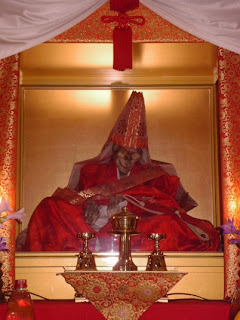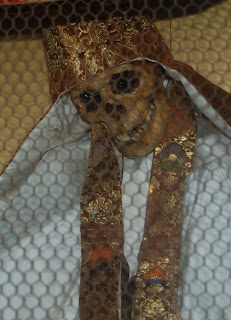For Halloween in Japan, I read Japanese Ghost Stories: Spirits, Hauntings and Paranormal Phenomena by Catrien Ross. The majority of the book was about psychic ability and things like automatic writing, telekinesis, and the like, things that don't really interest me much. But the last three or four chapters were devoted to haunted or otherwise anomalous places around Japan, including Zenpoji temple in Tsuruoka City, Yamagata prefecture, where there is reportedly a fish with a human face. A quick Google search turned up nothing on this fish in Zenpoji, though human-faced fish are a mainstay of Cheongju (청주/淸州), Chungcheongbuk-do, South Korea.
However, by far the most striking memory of this read was the Buddhist mummies of Gassan, otherwise known as "flesh body bodhisattvas", or Sokushinbutsu (即身仏) in Japanese. A group of ascetic practitioners of Shingon Buddhism, these worships undertake a decade-long annihilation of their bodies in order to achieve freedom from samsara in their current lifetime. If successful, their bodies would be perfectly preserved for all time, but if they failed, and in the end decomposed, then....well, the effort was appreciated, but they had to start all over again in another lifetime.
The erasure of their physical being is one of the more gruesome rituals I've ever known human beings to willingly submit to. (I suppose the most gruesome submission of oneself to certain death I know of is the Russian drug krokodil, if you call that willing.) Having precedents in China and Tibet, the Sokushinbutsu's ritual is described by Aaron Lowe in the journal Agora:
"The process of self-mummification is broken down into three 1,000-day periods. Each period is
characterized by physical and mental changes caused by phase-specific austerities and excruciating pain.
The process is not some mystic secret, but rather a calculated scientific means for ridding the body of
material that cannot cross over into nirvana. In the first phase the priest is restricted to a diet of only nuts
and grains surrounding the temple complex.11 During this time the practitioner endures extreme hardships,
such as meditating under icy cold mountain streams for hours on end. “Japan is a mountainous country.”12
Therefore, most of the Shingon temple complexes are in the proximity of large sacred mountains.
"During the second phase of the process, the fat matter that causes the body to decompose is greatly
reduced. Upon entering the second one thousand-day period, the priest’s body fat is near zero. In this
stage, the diet is restricted even further to only miniscule amounts of pine bark and roots from pine trees.
After this stage, the priest is like a “skin-covered skeleton.”13 The dehydration helps in preservation of the
body. Towards the end of the second stage, “A special tea is made from the sap of the urushi tree.” This
sap is used as a lacquer for furniture. The tea is a poisonous concoction that causes vomiting and
sickness that further decrease the moisture in the body, but more importantly, its build up in the system
prevents insects from speeding up the decomposition process. This, in turn, helps the self-mummification
process by protecting the to-be mummified priest from natural elements.
"Upon entering the final stage, the priest is given a bell and then sealed in his tomb where a tube is
inserted into a small opening in the top. Every day, he rings the bell. Eventually, when the ringing stops,
the tube is removed. 14 At the end of the last 1000-day period, nearly ten years after starting, the tomb is
opened and the results are seen. Out of the thousands who have tried to complete this decade long
process, most are decomposed, and thus, have failed in their efforts. Only a select few actually achieve
this fascinating but grisly transformation. The priests who triumphed in their endeavor are said to be one
with the cosmic Buddha. While the people who tried and failed are praised for their fervor, they are not
thought to be Buddha. Therefore, they enter back into the wheel of Samsara."
There is a 30-second video from inside one museum on Youtube. (Apparently, there is also a documentary about the Yamagata temples, with a short preview here.) Another great site for reading about/viewing photos is on Environmental Graffiti. More than anything else, the mummies remind me of the Templar, horse-mounted zombies of Amando de Ossorio's Tombs of the Blind Dead, perhaps a crass observation given the sacred nature of the Gassan monks.








